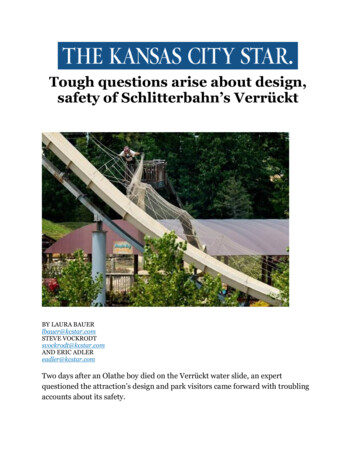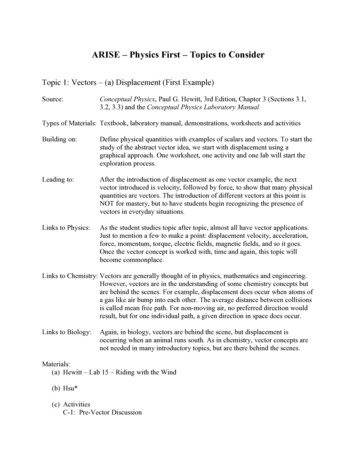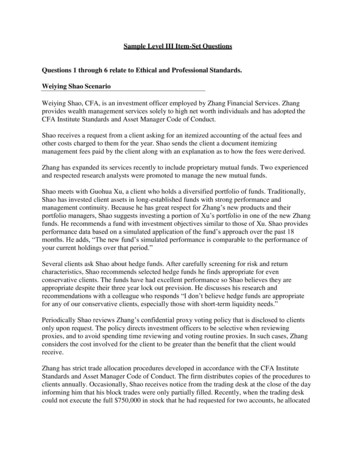
Transcription
Tough questions arise about design,safety of Schlitterbahn’s VerrücktWoman ls when friend's harness came off during rideBY LAURA BAUERlbauer@kcstar.comSTEVE VOCKRODTsvockrodt@kcstar.comAND ERIC ADLEReadler@kcstar.comTwo days after an Olathe boy died on the Verrückt water slide, an expertquestioned the attraction’s design and park visitors came forward with troublingaccounts about its safety.
Past riders recounted scary examples of harnesses coming loose and one instanceof a boat lifting into the air as it plunged down the slide.A Schlitterbahn season ticket holder said she once asked a worker atop the slidewhether the hook-and-loop harness would keep her from flying out of the boat.Erica Conrad of Linwood, Kan., said that the worker “assured me, ‘It’s OK, they’renot to keep you in the raft, but to make you feel safer.’ ”Police said that Caleb Thomas Schwab, 10, son of Kansas Rep. Scott Schwab, wasdecapitated on the ride Sunday, a horrific conclusion to a day when electedofficials and their families were invited to enjoy a free visit.On Tuesday, the Verrückt’s designer and operator, Schlitterbahn, continued itssilence on the matter, even when asked about the reports of the airborne boat andloose harnesses. The company did announce that the park would reopen at noonWednesday, but that Verrückt would be closed for the rest of the season.An expert interviewed by The Star said the use of netting over the slide and theuncontrolled nature of the boats — they weren’t attached to a rail like a rollercoaster — especially need to be scrutinized.Mark Hanlon, a licensed mechanical engineer who was a certified inspector ofamusement attractions in California, said that while the Verrückt resembled aroller coaster ride, it did not have similar safety precautions, such as having avehicle tied to a rail line.“Roller coasters, they’re fully captured,” Hanlon said. “They can’t go vertical, theycan’t go sideways, they can’t go down.”One Kansas family who recently visited the park experienced a ride on theVerrückt that showed the danger of not having the boats tied to a rail. Instead,they slide on a film of water.Jon Powell of Hutchinson said that three weeks ago, the boat carrying hisdaughter’s family — her, her husband and their 8-year-old daughter — wentairborne.They called him immediately to tell him what had happened.“It kind of scared the heck out of them,” Powell said. “They didn’t think anythingof it until they were met by staff at the bottom.”
The lifeguard at the top of Verrückt had radioed down to the lifeguard at thebottom of the ride to report that the raft had gone airborne, Powell said.Management met the family once they got off the ride.“They kept asking them, ‘Are you OK? Are you OK?’ ” Powell said. Park staff “toldthem, ‘That’s not supposed to happen.’ ”The three weren’t injured, and the reality of what had happened didn’t sink inuntil later, Powell said.Verrückt puts three restrained riders on a boat that embarks on an initial 17-storydrop, reaching speeds up to 70 mph. Then it rises and descends on a hump andstops in a shallow pool.Netting all along the slide over the riders is intended to keep them from falling offthe slide. It’s propped up every few feet by what appear to be metal semicircularpoles.But the netting also drew concern from Hanlon. He said it presents risks to ridersif they come into contact with it at high speeds.“It will literally pull someone’s arm right off,” Hanlon said.After Caleb’s death, authorities removed a portion of the netting that covered theinitial part of the second descent.Too much speed?As far as the ride’s riskiness, science can explain that, said one expert contactedby The Star. Tim Landschoot is a mechanical engineer and lecturer at New York’sRochester Institute of Technology. He is the faculty adviser to the university’stheme park engineering program, and he uses the Verrückt to teach fundamentalprinciples of physics.At its root, the science of the ride is not complex. Like roller coasters and otherthrill rides, it centers on the acceleration of a body in motion, in this case a boatcontaining riders.The height of the ride — higher than the Statue of Liberty — combined with theweight of the boat and the passengers, imbues the combined boat and its riderswith loads of potential energy, ready to be unleashed.
“It’s not a vertical drop, but it’s a steep drop,” Landschoot said.As soon as the boat begins its 168-foot first drop, the acceleration of gravity takesover. The potential energy of the the boat is converted into kinetic energy, so thatby the time the raft gets to the bottom of the drop, it hits what the designersintended to be its maximum speed, 65 to 70 mph.“As soon as you step out, you have no real support on you. Gravity is going tostart pulling you down,” said Paul Rulis, a professor of physics at the Universityof Missouri-Kansas City.Air resistance and the friction of the water may slow down the boat a bit, but notmuch.At the bottom of the initial drop, the raft now has momentum (mass multipliedby velocity) to help propel it some 50 feet up another five stories and over theVerrückt’s final rise.“The last thing you want is too much speed,” Landschoot said. “On the secondhump, you don’t want to actually go flying off, leave the slide. You want to go slowenough so you are riding over it and not just jumping over it.”Once the raft reaches the top of the rise, the weight of the boat and passengerspulled down by gravity takes over once again. Gravity pulls the raft and ridersdown the chute. Friction and water resistance deplete the raft’s energy as itcruises to a stop.“If it performs as expected, the raft stays on the water and on the slide. And that’sgood,” he said. “But if a restraint or harness has given way, that’s bad.”It’s bad because, as physics dictates, a body in motion will remain in motion andin a straight line unless acted on by another force.If a rider is speeding over the rise and, for whatever reason, the harness givesway, physics dictates that the individual will continue in a straight line, flying outof the seat as the boat and its other passengers continue to drop to the poolbelow.The forces acting on riders are why the harnesses are so critical.
But Frank Branson, a Dallas attorney who has represented victims in amusementpark incidents, questioned the efficacy of hook-and-loop restraints on highvelocity rides.“I’m not sure at the speed they say they’re going that Velcro is a good fastener,and how did they determine Velcro was a good fastener?” Branson said.Experts also say hook-and-loop products experience wear and tear over time,which reduces their strength, making it easier for someone to unfasten them.Hook-and-loop products are commonly called Velcro, which is a brand name forthe popular fastener. Velcro Companies said in a statement that Schlitterbahnwas not one of its customers.“Velcro Companies doesn’t manufacture products for amusement park rides,”said spokeswoman Amy Thompson, “and no they don’t sell products toamusement park operators for the purpose of harnessing guests on rides.”Other companies also make such fasteners.‘Our hearts break’Several riders told The Star on Tuesday they experienced mishaps and faultyequipment on the Verrückt before Sunday’s tragedy.Conrad, who has ridden the ride before and was told not to worry about the safetyof the harnesses, was at the bottom of the Verrückt last summer, taking photos,as her husband, a friend and her young cousin zoomed down the slide.“When they got to the bottom, we realized (their friend) Matt’s strap was off,”said Conrad, “We didn’t realize it until Matt yelled, ‘My strap came off.’ ”A lifeguard who would have heard the comment “didn’t act like it was any bigdeal,” Conrad said. So the group didn’t report the issue.After Sunday, Conrad wanted people to know what her family and friendexperienced. Other families have also come forward to detail frighteningexperiences.“I just want the word out there,” she said. “I’ve always thought that the Velcroseat belts were not appropriate for a ride that fast or that tall.”
On July 26, Paul and Erin Oberhauser of Omaha, Neb., took their family toSchlitterbahn and a few in the group went on the water slide. When they heardabout Caleb’s death, they thought back to their own experience when Paul’sshoulder strap came loose at the bottom of the first hill.“He said it just happened so fast,” Erin Oberhauser told The Star. Her husbandheld on tight to handles by his legs for the rest of the ride, she said.When he got off, he told workers what had happened. They said, “Oh, that’s notgood,” Erin Oberhauser said.The family figured the raft would be taken out of commission until workers couldfigure out the problem. But two hours later, Erin Oberhauser said, from theircabana near the water slide, they saw it happen to another guy on the ride.“We heard a guy yelling, ‘My belt came undone!’ ”Erin Oberhauser later posted about the experience on Facebook, taggedSchlitterbahn and included the hashtag Verrückt. She didn’t hear anything fromthe park.The Oberhausers hope Caleb’s family hears about issues previously reported atthe park.“We wanted Kansas City to know what happened, because our hearts break forthe Schwabs,” Erin Oberhauser said. “ We want the family to be able to see thatit happened to others. That’s all we want.”Brian Mercer, a regional director for the Missouri Parent Teacher Association,shared in public tweets his concerns about the Verrückt slide this week. He wrotethat he had ridden the slide twice this summer and was concerned about thestraps that held riders in.“I remember thinking ‘shouldn’t this be a seat belt holding me in instead ofVelcro?’ I assumed they knew what they were doing. #Verrückt,” Mercer tweeted.Before Sunday, Hanlon said, Schlitterbahn had a reputation for safety.“They’re a class-A operation,” he said. “I was taken aback that this thinghappened at Schlitterbahn. It was a surprise. It’s not what I expected out ofthem.”
“I just think they made a lot of freshman mistakes that were completely avoidablein this day and age.”Kirsty Ferzgussen @kellyfitzp#Schlitterbahn is quick to announce it's reopening Wednesday but refuses to releaseinformation about the circumstances of the incident?3:53 PM - 8 Aug 2016 · Kansas City, MO, United StatesTHE STAR’S KATY BERGEN CONTRIBUTED TO THIS REPORT.Read more here: 87.html#storylink cpy
Aug 08, 2016 · But Frank Branson, a Dallas attorney who has represented victims in amusement park incidents, questioned the efficacy of hook-and-loop restraints on high-velocity rides. “I’m not sure at the speed they say they’re going that Velcro is a good fastener, and how did they determine Ve











